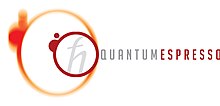 | |
| Developer(s) | Quantum ESPRESSO Foundation (QEF) |
|---|---|
| Stable release | 7.4 / October 21, 2024; 2 months ago (2024-10-21) |
| Repository | gitlab.com/QEF/q-e |
| Written in | Fortran, C |
| Operating system | Linux, macOS |
| License | GNU General Public License |
| Website | quantum-espresso.org |
Quantum ESPRESSO (Quantum Open-Source Package for Research in Electronic Structure, Simulation, and Optimization; QE) is a suite for first-principles electronic-structure calculations and materials modeling, distributed for free and as free software under the GNU General Public License. It is based on density functional theory (DFT), plane wave basis sets, and pseudopotentials (both norm-conserving and ultrasoft).
The core plane wave DFT functions of QE are provided by the PWscf component (PWscf previously existed as an independent project). PWscf (Plane-Wave Self-Consistent Field) is a set of programs for electronic structure calculations within DFT and density functional perturbation theory, using plane wave basis sets and pseudopotentials. The software is released under the GNU General Public License.
The latest version QE-7.4 was released on 21 October 2024.
Quantum ESPRESSO Project
Quantum ESPRESSO is an open initiative of the CNR-IOM DEMOCRITOS National Simulation Center in Trieste (Italy) and its partners, in collaboration with different centers worldwide such as MIT, Princeton University, the University of Minnesota and the École Polytechnique Fédérale de Lausanne. The project is coordinated by the QUANTUM ESPRESSO foundation, which was formed by many research centers and groups all over the world. The first version, called pw.1.0.0, was released on 15-06-2001.
The program is written mainly in Fortran-90 with some parts in C or in Fortran-77. It is composed of a set of core components, a set of plug-ins for advanced tasks, and a set of third-party packages.
The basic packages include Pwscf, which solves the self-consistent Kohn-Sham equations, obtained for a periodic solid, CP to carry out Car-Parrinello molecular dynamics, and PostProc, which allows data analysis and plotting. Noteworthy additional packages include atomic for pseudopotential generation, PHonon for density-functional perturbation theory (DFPT) and the calculation of second- and third-order derivatives of the energy with respect to atomic displacements, and NEB (nudged elastic band) for the calculation of reaction pathways and energy barriers.
Target problems
The different tasks that can be performed include
- Ground state calculations
- Structural optimization
- Transition states and minimum energy paths
- Response properties (DFPT), such as phonon frequencies, electron-phonon interactions and EPR and NMR chemical shifts
- Ab initio molecular dynamics: Car-Parrinello and Born-Oppenheimer MD
- Spectroscopic properties
- Quantum import
- Generation of pseudopotentials
Parallelization
The main components of the Quantum ESPRESSO distribution are designed to exploit the architecture of today's supercomputers, which are characterized by multiple levels and layers of inter-processor communication. Parallelization is achieved using both MPI and OpenMP, allowing the main codes of the distribution to run in parallel on most or all parallel machines with very good performance.
See also
References
- "Quantum ESPRESSO Foundation - Home of the Quantum ESPRESSO Foundation".
- Paolo Giannozzi; Stefano Baroni; Nicola Bonini; Matteo Calandra; Roberto Car; Carlo Cavazzoni; Davide Ceresoli; Guido L Chiarotti; Matteo Cococcioni; Ismaila Dabo; Andrea Dal Corso; Stefano de Gironcoli; Stefano Fabris; Guido Fratesi; Ralph Gebauer; Uwe Gerstmann; Christos Gougoussis; Anton Kokalj; Michele Lazzeri; Layla Martin-Samos; Nicola Marzari; Francesco Mauri; Riccardo Mazzarello; Stefano Paolini; Alfredo Pasquarello; Lorenzo Paulatto; Carlo Sbraccia; Sandro Scandolo; Gabriele Sclauzero; Ari P Seitsonen; Alexander Smogunov; Paolo Umari & Renata M Wentzcovitch (2009). "QUANTUM ESPRESSO: a modular and open-source software project for quantum simulations of materials". Journal of Physics: Condensed Matter. 21 (39): 395502. arXiv:0906.2569. Bibcode:2009JPCM...21M5502G. doi:10.1088/0953-8984/21/39/395502. PMID 21832390. S2CID 5846317.
- P. Giannozzi; O. Andreussi; T. Brumme; O. Bunau; M. Buongiorno Nardelli; M. Calandra; R. Car; C. Cavazzoni; D. Ceresoli; M. Cococcioni; N. Colonna; I. Carnimeo; A. Dal Corso; S. de Gironcoli; P. Delugas; R. A. DiStasio Jr.; A. Ferretti; A. Floris; G. Fratesi; G. Fugallo; R. Gebauer; U. Gerstmann; F. Giustino; T. Gorni; J. Jia; M. Kawamura; H.-Y. Ko; A. Kokalj; E. Küçükbenli; M. Lazzeri; M. Marsili; N. Marzari; F. Mauri; N. L. Nguyen; H.-V. Nguyen; A. Otero-de-la-Roza; L. Paulatto; S. Poncé; D. Rocca; R. Sabatini; B. Santra; M. Schlipf; A. P. Seitsonen; A. Smogunov; I. Timrov; T. Thonhauser; P. Umari; N. Vast; X. Wu & S. Baroni (2017). "Advanced capabilities for materials modelling with Quantum ESPRESSO". Journal of Physics: Condensed Matter. 29 (46): 465901. arXiv:1709.10010. Bibcode:2017JPCM...29T5901G. doi:10.1088/1361-648X/aa8f79. PMID 29064822. S2CID 3950531.
- Corso, Andrea Dal (1996). "A Pseudopotential Plane Waves Program (PWSCF) and some Case Studies". Quantum-Mechanical Ab-initio Calculation of the Properties of Crystalline Materials. Lecture Notes in Chemistry. Vol. 67. Springer, Berlin, Heidelberg. pp. 155–178. doi:10.1007/978-3-642-61478-1_10. ISBN 9783540616450.
- Bunău, Oana; Matteo, Calandra (2013). "Projector augmented wave calculation of x-ray absorption spectra at the L 2, 3 edges". Physical Review B. 87 (20): 205105. arXiv:1304.6251. Bibcode:2013PhRvB..87t5105B. doi:10.1103/PhysRevB.87.205105. S2CID 52199435.
- Gougoussis, Christos; Calandra, Matteo; Seitsonen, Ari P.; Mauri, Francesco (2009). "First-principles calculations of X-ray absorption in an ultrasoft pseudopotentials scheme: from $\alpha$-quartz to high-T$_c$ compounds". Phys. Rev. B. 80 (7): 075102. doi:10.1103/PhysRevB.80.075102.
External links
| Computational chemistry software | |||||
|---|---|---|---|---|---|
| Cheminformatics |
| ||||
| Chemical kinetics |
| ||||
| Molecular modelling and visualization | List of molecular graphics systems
| ||||
| Molecular docking | List of protein-ligand docking software
| ||||
| Molecular dynamics |
| ||||
| Quantum chemistry | List of quantum chemistry and solid-state physics software
| ||||
| Skeletal structure drawing |
| ||||
| Others |
| ||||